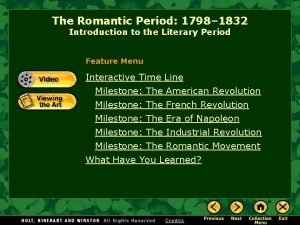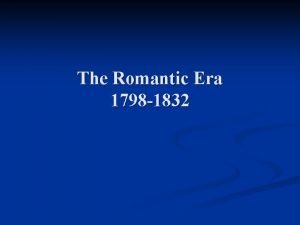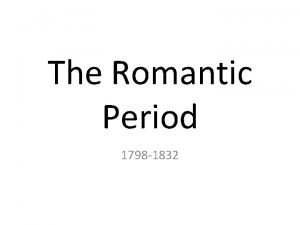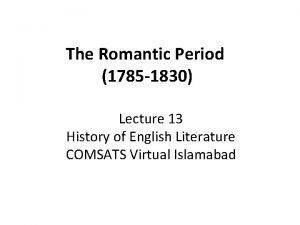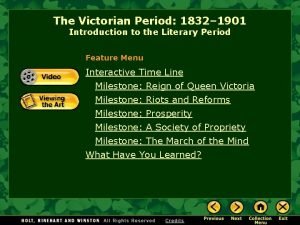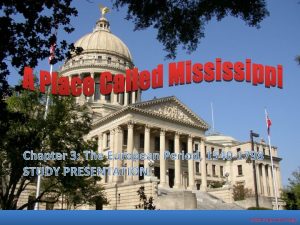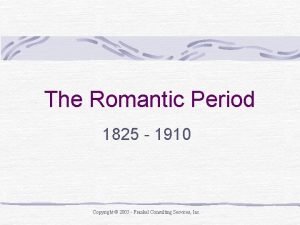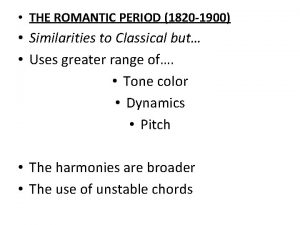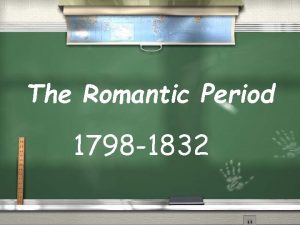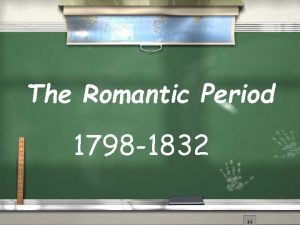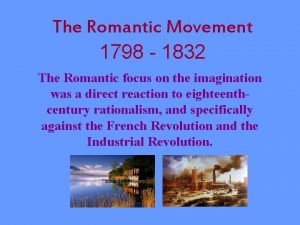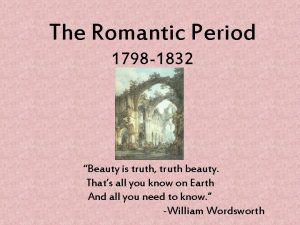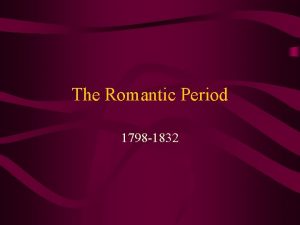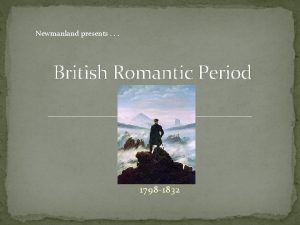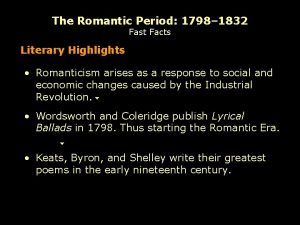The Romantic Period 1798 1832 Introduction to the














- Slides: 14

The Romantic Period: 1798– 1832 Introduction to the Literary Period Feature Menu Interactive Time Line Milestone: The American Revolution Milestone: The French Revolution Milestone: The Era of Napoleon Milestone: The Industrial Revolution Milestone: The Romantic Movement What Have You Learned?

The Romantic Period: 1798– 1832 Choose a link on the time line to go to a milestone. 1776– 1783 American Revolution 1799– 1815 Era of Napoleon 1789– 1799 French Revolution 1750 1800 late 1700 s Industrial Revolution 1850 late 1700 s–early 1800 s Romantic Movement

The American Revolution 1776– 1783: American Colonies revolt, defeat Britain, gain independence How American Revolution affected Britain: • Big psychological blow • Severe economic problems—war debts, no more revenue from Colonies • Government by personal power of king comes to an end

The French Revolution 1789: storming of the Bastille 1792: “September massacre” 1793: Louis XVI beheaded The French Revolution at first inspired liberals in England, scared conservatives Storming of the Bastille later turned violent, ended in dictatorship of Napoleon Bonaparte eventually led to conservative clamp-down in England

The Era of Napoleon Bonaparte—ruthless, tyrannical dictator of France; tried to take over Europe 1803– 1815 England at war with France 1815, Waterloo, Belgium England allies send Napoleon’s army back to France

The Industrial Revolution Beginning in England • Production moves from homes to factories • Factories located in cities • Communal land taken over by rich owners • People move to cities looking for work • City populations swell • Living conditions very poor

The Industrial Revolution Policy of Laissez Faire • laissez faire—”let (people) do (as they please)” • let business owners operate without government interference The Result: • Rich grew richer while poor suffered more • Children forced to do hard labor

The Romantic Movement The Romantics • were dedicated to social change • believed in individual liberty • valued imagination • thought of nature as transformative • focused on personal experience and emotions

The Romantic Movement Romanticism—Three Useful Meanings A Child’s Sense of Wonder Social Idealism Adaptation to Change Fascination with innocence, youth, and the child’s fresh way of perceiving the world Questioning authority and tradition in order to imagine happier, fairer, healthier ways to live Becoming more aware of change and finding ways to accept it and adapt to it

The Romantic Movement Lyrical Ballads, with a Few Other Poems • collaboration of Samuel Taylor Coleridge and William Wordsworth • published 1798 “A new kind of poetry”: • commonplace subjects; simple language • immediacy, spontaneity, emotion, self-revelation • celebrates bond between nature and the human mind

The Romantic Movement Some Romantic poets: William Blake George Gordon, Lord Byron But to the eyes of the man of imagination nature is imagination itself. As a man is, so he sees. . To me this world is all one continued vision of fancy or imagination. —William Blake John Keats Percy Bysshe Shelley

The Romantic Movement The Lure of the Gothic Horror tales and Gothic architecture were popular in the Romantic period. Strawberry Hill • medieval-style, rustic, eerie castle • built by Horace Walpole The Castle of Otranto • horror tale, first Gothic novel • by Horace Walpole, 1764

What Have You Learned? Choose the correct answer to each question. 1. Which of the following was NOT a result of the Industrial Revolution? a. a. pay raises b. poverty c. crowded cities 2. Which of the following was NOT important to the Romantics? a. nature b. order c. social change 3. Which of the following was NOT a Romantic poet? a. Wordsworth b. Keats c. Pope

END
 The romantic period 1798 to 1832 summary
The romantic period 1798 to 1832 summary The romantic period 1798 to 1832
The romantic period 1798 to 1832 The romantic period 1798 to 1832 summary
The romantic period 1798 to 1832 summary Romantic age starts from
Romantic age starts from The romantic age (1798 to 1824)
The romantic age (1798 to 1824) Romantic period 1785 to 1830 significant events
Romantic period 1785 to 1830 significant events The romantic age (1798 to 1824)
The romantic age (1798 to 1824) Music of the classical period (1750 to 1820)
Music of the classical period (1750 to 1820) Victorian age 1832 to 1901
Victorian age 1832 to 1901 The victorian period (1832–1901)
The victorian period (1832–1901) Chapter 3 the european period answers
Chapter 3 the european period answers The tristan chord
The tristan chord Romantic period american literature
Romantic period american literature Romantic period characteristics
Romantic period characteristics Facts about romantic period
Facts about romantic period
